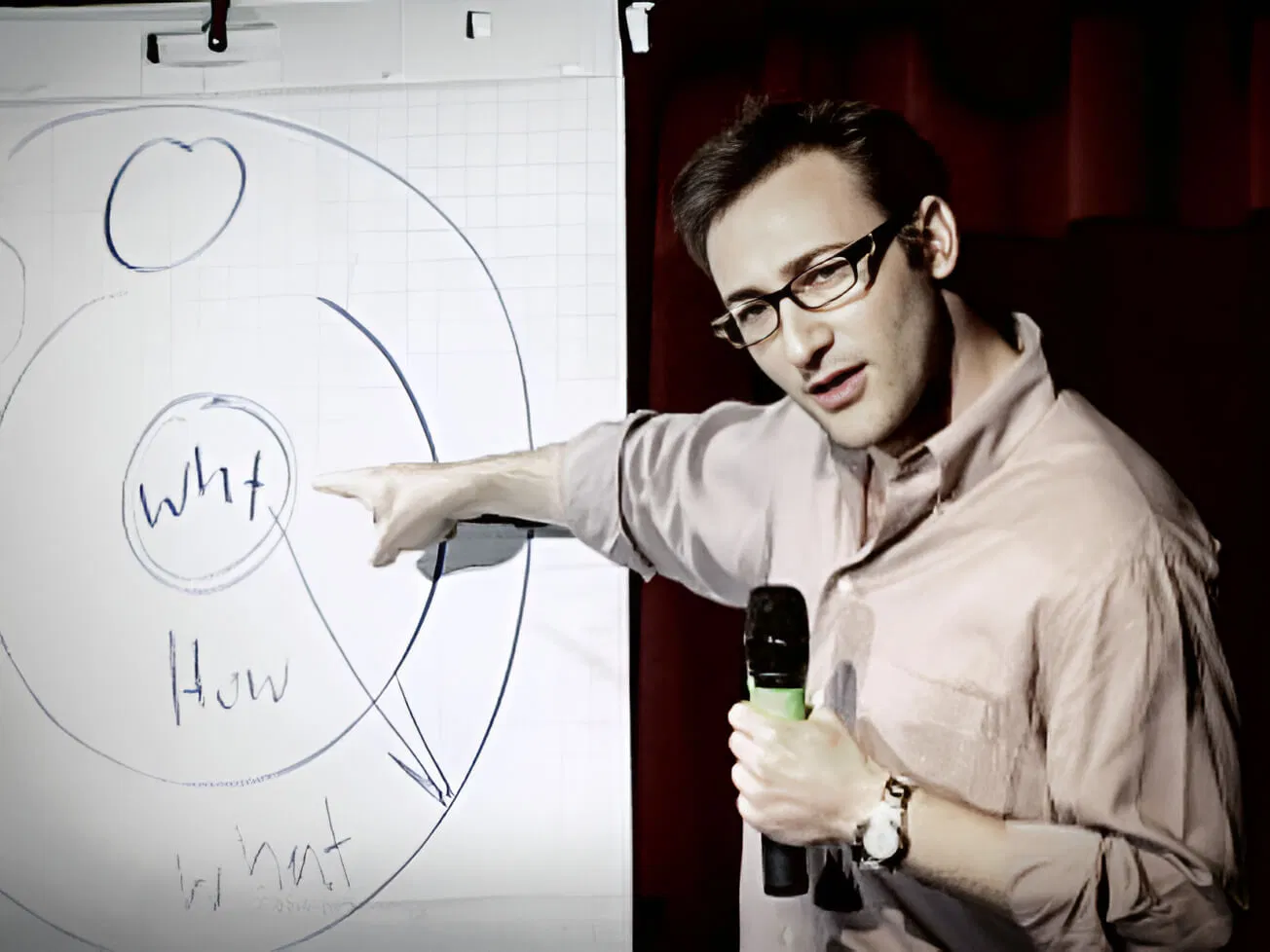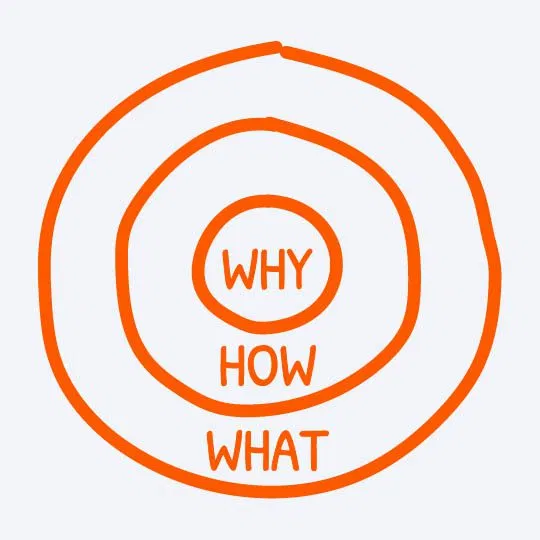Start With The Why
Unleash the power of "Why". Discover your purpose, inspire action and drive success with the Golden Circle by Simon Sinek
Request a free consultation today

"People don’t buy WHAT you do, they buy WHY you do it."
Simon Sinek
DE PAULA
The Golden Circle philosophy, developed by Simon Sinek, helps individuals and organisations uncover their purpose, communicate effectively, and inspire action. Discover the power of starting with "Why" to drive success in your life and with your business.
Simon Sinek

The Golden Circle Philosophy
The Golden Circle philosophy, developed by Simon Sinek, is a powerful framework that can help individuals and organisations uncover their purpose, communicate their message effectively, and inspire others to take action. By understanding and applying the principles of the Golden Circle, individuals and organisations can create a strong sense of direction, build meaningful relationships, and drive positive change.
At the core of the Golden Circle is the concept of starting with "Why." Sinek argues that most people and organisations focus on the "What" and "How" aspects of their work, such as the products they sell or the services they provide, and the processes they use to differentiate themselves from others. However, he suggests that truly successful individuals and organisations begin by clarifying their purpose, their reason for existence.
Why
The "Why" circle represents the innermost layer of the Golden Circle. It encapsulates the core beliefs, values, and purpose that drive an individual or organisation. It is the driving force behind everything they do and serves as the foundation for their actions and decisions. When individuals and organisations are deeply connected to their "Why," it becomes a powerful source of inspiration and motivation.
How
Moving one layer outward, we find the "How" circle. This circle represents the unique approach or methodology that an individual or organisation uses to bring their purpose to life. It outlines the specific actions, strategies, and processes employed to fulfil their mission and create value. By clearly articulating their unique approach, individuals and organisations can differentiate themselves from others in their field.
What
Finally, we arrive at the outermost circle, the "What." This circle represents the tangible products, services, or offerings that an individual or organisation provides to the world. These are the outcomes or manifestations of their purpose and approach. By starting with a clear understanding of their "Why" and "How," individuals and organisations can align their "What" with their deeper sense of purpose and create products or services that truly resonate with their audience.
The power of the Golden Circle lies in its ability to inspire others. When individuals and organisations communicate from the inside out, beginning with their purpose (the "Why"), they tap into the emotional drivers that motivate people to action. By sharing their beliefs, values, and purpose in a compelling way, they can connect with like-minded individuals who share their vision and attract loyal supporters.
Moreover, the Golden Circle philosophy emphasises the importance of authenticity and consistency in communication. It encourages individuals and organisations to stay true to their purpose and values in all aspects of their work. Authenticity builds trust, credibility, and loyalty among customers, employees, and other stakeholders.
"The inspired leaders - every single one of them, regardless of their industry - think, act, and communicate from the inside out."
Simon Sinek
The impact of the Golden Circle philosophy can be seen across various industries and sectors. It has been adopted by leaders in business, education, healthcare, and other fields who strive to create a meaningful difference in the world. By leading with purpose and effectively communicating their message, these individuals and organisations have been able to inspire others, drive innovation, and make a lasting impact.
Summary
In conclusion, the Golden Circle philosophy provides a powerful framework for individuals and organisations to define their purpose, communicate it effectively, and inspire others to take action. By starting with the "Why," individuals and organisations can tap into a deeper sense of meaning and create connections that drive positive change. Whether on an individual or organisational level, embracing the Golden Circle philosophy can lead to greater fulfilment, success, and impact in today's world.
FAQ
What is the Golden Circle philosophy by Simon Sinek?
The Golden Circle philosophy, introduced by Simon Sinek, is a concept that explains how successful individuals and organizations communicate and inspire action. It consists of three concentric circles: Why, How, and What. According to Sinek, starting with the "Why" (the purpose or belief that drives you), then moving to the "How" (the process or approach), and finally the "What" (the product or service) allows for more effective communication and engagement with customers.
How can I apply the Golden Circle philosophy to my business?
To apply the Golden Circle philosophy to your business, start by clearly defining your why. Understand the core purpose and values that drive your organization. Then, determine the how – the unique processes or approaches that differentiate your business. Finally, articulate the what – the specific products or services you offer. By communicating in this order, you can attract customers who align with your purpose and create a stronger connection with them.
How can I effectively communicate my why, how, and what to potential customers?
To effectively communicate your why, how, and what to potential customers, focus on storytelling. Craft a compelling narrative that highlights your purpose and values (why), explains your unique approach or processes (how), and clearly describes your products or services (what). Use a combination of visual elements, persuasive language, and testimonials to engage and connect with your audience on an emotional level.
Are there any case studies or success stories of businesses implementing the Golden Circle philosophy?
Yes, there are several case studies and success stories of businesses that have successfully implemented the Golden Circle philosophy. Examples include Apple Inc., which focuses on its why (challenging the status quo), Southwest Airlines (why: democratizing air travel), and Patagonia (why: saving our planet). These companies have effectively communicated their purpose and values, leading to increased brand loyalty and customer engagement.
Does the Golden Circle philosophy apply to all types of businesses?
Yes, the Golden Circle philosophy can be applied to businesses of all types and sizes. Whether you're a small startup, a non-profit organization, or a multinational corporation, understanding and effectively communicating your why, how, and what can help you establish a strong brand identity and connect with your target audience.
Can the Golden Circle philosophy be used for personal branding?
Absolutely! The Golden Circle philosophy can be applied to personal branding as well. By identifying and articulating your personal why (your values, passions, and purpose), how (your unique skills, experiences, and approach), and what (the specific offerings you provide), you can create a compelling personal brand story that resonates with others and helps you stand out in your field.
Is it necessary to have a unique why in order to be successful?
While having a unique why can certainly differentiate your business or personal brand, it's not the only factor for success. It's more important to have a clear and authentic why that resonates with your target audience. Focus on articulating why you do what you do in a way that connects emotionally with your customers and sets you apart from competitors.
Can the Golden Circle philosophy help with customer retention?
Yes, implementing the Golden Circle philosophy can help with customer retention. When customers feel a strong emotional connection to your brand and understand its purpose and values, they are more likely to remain loyal and continue supporting your business. By consistently communicating your why, how, and what throughout the customer journey, you can foster long-term relationships and increase customer retention rates.
Are there any potential challenges or pitfalls when applying the Golden Circle philosophy?
One potential challenge when applying the Golden Circle philosophy is ensuring consistency in your messaging across different channels and touchpoints. It's important to maintain alignment between your why, how, and what in all communications – from your website to social media platforms. Another challenge may be accurately identifying and articulating your why, as it requires deep introspection and understanding of your core values.
Can the Golden Circle philosophy help with employee engagement?
Absolutely! The Golden Circle philosophy is not limited to external communication; it can also be applied internally to enhance employee engagement. When employees understand and connect with the purpose and values of the organization, it fosters a sense of belonging and motivation. By aligning internal communication with the why, how, and what, you can inspire and empower employees to contribute positively to the company's success.
How often should I revisit and reassess my why, how, and what?
It's important to periodically revisit and reassess your why, how, and what to ensure they remain relevant and aligned with your evolving business or personal brand. Changes in market trends, customer preferences, or internal factors may warrant adjustments. Consider revisiting these elements during strategic planning sessions or when significant changes occur within your industry.
Where can I find more resources or information about the Golden Circle philosophy?
To learn more about the Golden Circle philosophy by Simon Sinek, you can visit Simon Sinek's official website or read his book "Start With Why." Additionally, there are numerous articles, videos, and podcasts available online that discuss and analyze the concept in detail.